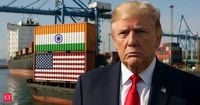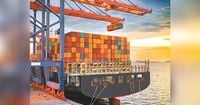In a dramatic escalation of economic tensions, the United States is set to impose a sweeping 50 percent tariff on Indian exports, a move that has sent shockwaves through India’s manufacturing hubs and rattled the global trade landscape. The decision, announced by President Donald Trump and formalized by the US Department of Homeland Security, takes effect at 12:01 am Eastern Daylight Time on August 27, 2025, and is already causing severe disruptions across India’s key export sectors.
According to The Indian Express and The Economic Times, the Federation of Indian Export Organisations (FIEO) revealed on August 26 that textile and apparel manufacturers in Tirupur, Noida, and Surat—three of India’s largest garment-producing regions—have halted production. The reason? Worsening cost competitiveness in the wake of the US tariff hike, which doubles existing duties to the highest rate globally. The impact is immediate and profound, as manufacturers grapple with a pricing disadvantage of 30–35 percent compared to rivals in China, Vietnam, Cambodia, the Philippines, and other Asian economies.
“Textiles and apparel manufacturers in Tirupur, Noida, and Surat have halted production amid worsening cost competitiveness. This sector is losing ground to lower-cost rivals from Vietnam and Bangladesh. As for seafood, especially shrimps, since the US market absorbs nearly 40 percent of Indian seafood exports, the tariff increase risks stockpile losses, disrupted supply chains, and farmer distress,” FIEO President S C Ralhan said in a statement carried by Business Standard.
The numbers underscore the gravity of the situation: approximately 55 percent of India’s US-bound shipments—valued at $47–48 billion—are now exposed to these punitive tariffs. For exporters, this means that Indian goods are suddenly far less attractive to American buyers, who can turn to cheaper alternatives from other countries. The textile and apparel sector, which has long been a cornerstone of India’s export economy, now faces an existential threat. “50 percent US tariffs will severely disrupt the flow of Indian goods to its largest export market and could severely impact India’s exports to the US,” Ralhan warned, echoing the concerns of thousands of businesses and workers whose livelihoods depend on international trade.
The pain is not limited to textiles. Labor-intensive sectors such as leather, ceramics, chemicals, handicrafts, carpets, and especially seafood—where the US is a major buyer—face similar headwinds. According to FIEO, “delays, order cancellations, and negated cost advantages loom large over these sectors.” The risk of unsold stockpiles and broken supply chains is real, and the threat of job losses hangs over entire communities.
Why the sudden escalation? The US government’s rationale, as outlined in the draft notice from the Department of Homeland Security and reported by The Economic Times, is to counter what it perceives as threats posed by the Russian government. Specifically, the Trump administration has linked the new duties to India’s continued purchase of Russian oil—a policy Washington argues helps fund Moscow’s war against Ukraine. President Trump was blunt: “That’s going to be up to them. It takes two to tango, I always say, and they should meet,” he said, referring to stalled peace talks between Russia and Ukraine. The US has threatened further sanctions if no diplomatic breakthrough emerges.
India, for its part, has condemned the additional duties as “unfair, unjustified, and unreasonable.” Officials in New Delhi maintain that they will continue to protect national interests, even as they hope that progress in peace talks could eventually lead to the withdrawal of tariffs. Prime Minister Narendra Modi, speaking at a rally in Ahmedabad on August 25, struck a defiant note: “No matter how much pressure comes, we will keep increasing our strength to withstand it. Today, the Atmanirbhar Bharat Abhiyan is getting a lot of energy from Gujarat and behind this are two decades of hard work.” He promised, “From the soil of Ahmedabad, I wish to tell you, promise you from the land of Gandhi, that the interests of small entrepreneurs, shopkeepers, farmers and livestock rearers are of utmost priority for Modi... Dabav kitna hi kyun na aaye, hum jhelne ki apni takat badhate jayenge.”
Foreign Minister S Jaishankar, meanwhile, took a sharper tone in Delhi on August 23. “It’s ironic for a pro-business American administration to accuse others of doing business,” he remarked, adding, “If you don’t like Indian oil or refined products, don’t buy them. Nobody is forcing you. But Europe buys, America buys. So if you have a problem, just stop buying.” His comments, reported by The Economic Times, reflect growing frustration in India over what is seen as selective enforcement—Washington has so far avoided imposing similar tariffs on other major buyers of Russian crude, notably China.
The tariff increase has also put a freeze on US–India trade relations. A planned round of bilateral talks has been postponed, and economic friction between the two countries is expected to intensify. The Confederation of Indian Textile Industry (CITI) has called for immediate government intervention. “The government has been discussing with industry how it can come to our aid during this critical juncture. But given the gravity of the situation, it is our expectation that concrete measures in the form of fiscal support and policy decisions related to raw material availability will be taken immediately,” CITI Chairman Rakesh Mehra told The Indian Express. CITI is also asking for a moratorium on payment of principal and interest for loans for up to one year, as well as broader fiscal support to help exporters weather the storm.
FIEO has echoed these calls, urging the government to implement interest subvention schemes, provide export credit support, and ensure low-cost, easily available credit for micro, small, and medium enterprises (MSMEs). There are also appeals for expanding production-linked incentive (PLI) schemes, investing in infrastructure and cold-chain storage, and accelerating trade agreements with the European Union, Oman, Chile, Peru, the Gulf Cooperation Council, Africa, and other Latin American countries. “Leveraging the negotiating window for urgent diplomatic engagement with the US still remains the key. Yet another approach could be the promotion of Brand India and innovation through enhanced global branding, investment in quality certifications, and embedding innovation in export strategy to make Indian goods more attractive globally,” Ralhan said.
For now, the outlook is uncertain. Exporters, industry groups, and government officials are scrambling to find solutions as the clock ticks down to the August 27 implementation date. The steps taken now, FIEO warns, “will determine how effectively India withstands external shocks and reasserts its presence in the global export landscape.” The coming weeks will reveal whether India can adapt to this new reality—or whether the world’s largest democracy will see its export ambitions derailed by the sharpest tariff hike in recent memory.





